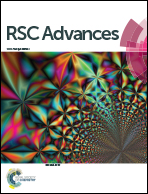Effects of electrolyte concentration and synthesis methods of sulfur/carbon composites on the electrochemical performance in lithium–sulfur batteries†
Abstract
Three synthesis methods are adopted in this study for the preparation of sulfur/carbon composites for rechargeable lithium–sulfur batteries, namely, melting (155 °C)-vaporizing (300 °C), ball milling, and ball milling-melting (155 °C). The structure, composition, and morphology of the samples are characterized by Brunauer–Emmett–Teller (BET), thermogravimetric (TG) analysis, X-ray diffraction (XRD), scanning electron microscopy (SEM), and elemental mapping analysis. The effects of electrolyte concentration and synthesis methods on the electrochemical performance of composites are also investigated. Results show that active sulfur disperses with carbon matrix more uniformly in the sulfur/carbon composite prepared by melting-vaporizing method. The assembled cell delivers an extraordinarily high initial discharge capacity of 1856.2 mA h g−1 when measured in the electrolyte with 5 M LiTFSI in DOL/TEGDME at a current density of 160 mA g−1; the capacity can still be retained at 905.3 mA h g−1 after 125 cycles. When measured at a higher current density of 800 mA g−1, a reversible capacity of 546.3 mA h g−1 can be maintained after 500 long-term cycles. The preferable electrochemical performance of the composite electrode is attributed to the high dispersibility of the carbon matrix and active sulfur in the composite, as well as the high concentration of lithium salt in the electrolyte. This work provides an optimized approach to obtain sulfur/carbon composites with remarkably improved electrochemical performance for lithium–sulfur batteries.


 Please wait while we load your content...
Please wait while we load your content...